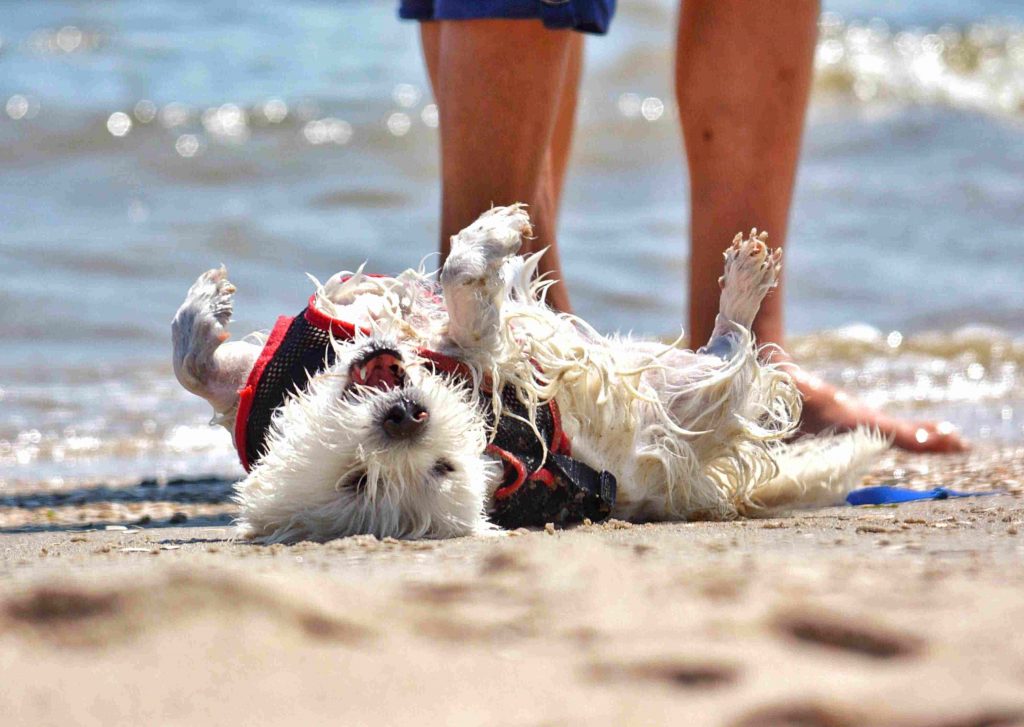Have you ever wondered what in the world your dog was trying to tell you? Dogs are non-verbal, which means they rely solely on body language. In fact, they have a whole language all to themselves. Spend an afternoon just watching your dog, and you may be surprised to see how much he communicates. Now there is no Dr. Doolittle, but we can do our best to respond correctly to these nonverbal cues. In short, learning your dog’s body language helps you be the best pet parent you can be for your furkid. We would call that a win!
Dog Body Language: Relaxed
Usually, you’ll see your dog relaxed when you two are at home together. While the seasoned traveler can be seen cool as a cucumber sticking his cold, wet nose out of a car window.
So, how can you tell when your dog is relaxed?
- His mouth may hang open slightly, but he does not pant.
- His eyes are bright and observant, but not guarded.
- His muscles and tail are relaxed into a natural state of being.
At this point, congratulate both of you that he feels relaxed and at ease.
If the dog you have is a new family member, it may take roughly 30-60 days to see this relaxed state. Encourage this feeling of wellbeing and home with a biscuit or pet.
Dog Body Language: Joyful
Good pet parents want their dogs to be happy. It makes the parent feel good, and of course, the dog feels good. But knowing when a dog is happy can help pet parents connect to their dogs in several different ways.
When your dog expresses joy:
- His ears may perk up, and his mouth may drop, and to pet parents, it looks like a smile.
- They may prance around on their toes, and wag their tail.
- Some dogs vocalize their pleasure by barking.
- Some of those dogs try to mimic human voices and learn to “talk” by grumbling and barking. Breeds such as huskies and hound dogs tend to be big talkers.
So how can you make a happy furkid?
Start by setting routines. Routines go a long way to make sure your pet knows when transitions happen; they will find joy in change. Dogs that never have a routine can feel uncertain more often. A routine can start simple, with feeding time and bedtime. Another example is if they get walked at a particular time every day by a dog walker or if you give them dental treats in the evening. Joy is sparked when their human mom or dad comes home for the day.
Finding their joy is also helpful when you pick out toys to entertain them, or treats to reward. Some dogs prefer hard Kong toys over plush toys and crunchy treats over soft ones. If you can distinguish what they like best, you will be their extra special, favorite person.
Dog Body Language: Playful
Just like with human children, dogs learn, explore, and grow through play. Some dogs prefer to play with their toys over playmates. While other dogs prefer to play with yard buddies at home, or the dog park. There are a ton of puzzle games dogs can play to keep their minds and bodies active.
Do you know when your dog is ready to play?
- The first sign you would likely see in your pet is the iconic play bow. The play bow is a familiar action to dog lovers. The dog’s front legs and head graze the ground, and their rump curves straight up to the tip of their wagging tail.
- They will tilt their head from side to side, looking at the plaything with curious eyes.
- You’ll see some panting.
- Nipping at their playmate is another way they play. But with this behavior, you should create boundaries for them. If your pet nips at your body, the general advice is to correct that behavior.
Setting boundaries for playtime is essential.
Like siblings roughhousing, someone is bound to get upset when playing inevitably escalates into overstimulation and fighting. When you set these boundaries, dogs are quicker to learn pack order (more about pack order later in this article).
Dog Body Language: Hyper
A hyper and overstimulated dog is like a bull in a china shop. Most pet parents see the same scene variation every night when they get home from work. Imagine this; you open the front door to find drooling adorable maniacs zooming around the living room furniture. Sound familiar?
What are the signs your pet is hyper?
- A hyper pet heavily pants and hangs its tongue far out of its mouth.
- You can see their muscles tense in movement and play anticipation.
- Their eyes widen, and they may tremble from adrenaline.
- It is common for them to exhibit the zoomies, and show behavior that they know is not tolerated like jumping on furniture or barking loudly.
Forewarning, a hyper dog has the potential to become overstimulated and get out of hand.
Quickly identify the source of your pet’s hyperactivity to figure out why they are so stimulated. Depending on the situation and with consideration of the weather, a water bowl should help cool things off. This behavior is typical for dogs when they are sequestered from human interaction all day. If they get this way when you arrive home, consider implementing some quality time with them in the evenings. Also, hiring a dog walking service to help expend that energy before you get home may help with the need to run off so much if you are in the Viera and Melbourne, FL area, so give us a call!
Dog Body Language: Nervousness
Nervousness can appear in unexpected situations and catch us oblivious humans off guard. Anyone working with animals will be familiar with what signs to look for. Trust your pet’s professionals, because that is where any pet parent could see this behavior for the first time. And since nervousness is usually a response that they are not comfortable with a particular situation, their fight or flight instinct comes out.
Many times, their cues will be subtle.
- When a dog is unsure, he will bow his nose and tail.
- Nervous urination may occur too.
- One thing a nervous dog will do that most pet parents don’t know about is lick. In a new or uncomfortable situation, your dog will hold his mouth open in a grin, and taste the air. Typically, it is followed by a little lick of his nose or your hand.
- A nervous dog will have wide, concerned eyes.
- And if a stranger approaches, he may curl his lips in a snarl.
Do not despair or overreact when your pet is nervous.
A nervous dog is not necessarily a fearful dog. The parent’s first reaction is to coddle this nervousness. It is in being confident in the situation that helps your dog feel like everything is going to be ok. Your dog should be handled by other people and exposed to different situations. Having visitors at your house, and taking him out into the public will make him feel at ease during times of change. We recommend using essential oils in the home and out of the house to help create a safe space, anywhere you go. Finally, if you are having trouble at the veterinarian’s office, ask to come in for a “Happy Visit” where your pets are showered with treats and cuddles instead of pokes and prods.
Dog Body Language: Fearful
The fearful dog is one that has crossed over from uncertain to afraid. He is often seen as a stray or in a stressful situation. If you have a rescue dog, it is more likely he is fearful of loud noises and sudden change. Like humans, pets retain their memories. They may not remember everything about a fearful situation, but there is something within the new situation they find reminiscent.
How can you tell when your dog is afraid?
- Any dog can be fearful.
- The dog may express uncertainty first, which gives humans a natural warning about the scene.
- But sometimes there is little to no warning.
- It is when they become genuinely fearful that caution should be taken, even if it is your own dog.
- “Whale eyes” is a common term used to describe the way a dog’s eyes widen in fear. They are noticeably rounder, and you can see the white of their eyes.
- Their pupils dilate, and they take rapid shallow breaths.
- Panting can be present right before and after physical exertion.
- Even if their muscles do not move, they will tense in preparation.
- What they do next is solely the fight or flight response.
- They may freeze.
- They may scream.
- They may eliminate all over themselves.
- They may growl.
- They may bite.
So what should you do if your dog becomes fearful?
The first step is to think ahead. If you know your pet will be fearful in an upcoming situation, you can speak with your veterinarian about ways to help. Some parents prefer to go a more natural route. But if you find yourself in an unexpected situation, you can help defuse the situation. You may show them who you trust by handing the leash to another person like the groomer, as your dog watches, it shows trust in that person. You can practice this with your dog by letting other people walk and handle your dog.
Additionally, what your body and voice are projecting goes a long way. If you are confident in the situation, your dog will be too. Finally, trust the professionals you have chosen to handle your dog successfully. Whether it is a dog walker, a veterinarian technician, dog trainer, or groomer, they will treat your pet with care and safety.
Dog Body Language: Aggressive
An aggressive dog is hardly that way from breed or birth alone. An aggressive dog can be found anywhere. Aggressive behavior usually appears during a fight or flight response, where the animal’s natural instinct is to fight. He is confident in his ability to overcome what is causing him distress. Pet parents, if your dog has ever shown aggression, it is important to figure out their trigger.
Signs of aggression in dogs include:
- Growling is the first sign, and you should view that as a fair warning.
- Pacing is a good indicator of aggression.
- He may snarl his lips and bare his teeth.
- His muscles will appear tense, and he may avoid eye contact.
- If he stares at you or someone else, do not attempt to make eye contact, he may perceive that as a threat and lunge.
- Finally, his fur may rise from his neck along his back.
Aggression is hardly any pet’s fault.
Pet parents are responsible for the actions of their pets. If you have an aggressive animal, you must take steps to correct that behavior before a dog bite happens. In most cases, aggression can be helped through behavioral therapy with a diligent pet parent willing to take the time to change their pet’s life. The solution to aggressive behavior is never a single action; it takes many tips and tricks to manage your dog’s aggression. Be patient and consistent with your dog. With time, love, and understanding those unwanted troublesome behaviors can be a thing of the past.
We hope this has given you a great start in learning how to read your pup’s body language so you can communicate better with your furry family member.

Melanie is the owner and founder of Brevard’s premier trusted in-home pet care company. With a Sociology & Criminal Justice degree from the University of Tennessee, she took her corporate security background and combined it with her lifelong passion for animals – that’s how Space Coast Pet Services was born in 2016! She is certified in Pet First Aid & CPR, insured, and proudly completed a full background check successfully. She is committed to ongoing training and education for herself and her team. To learn more, click here.
As an Amazon Associate, I earn from qualifying purchases. This small amount allows me to bring you resources that I use or have researched and recommend.






Recent Comments